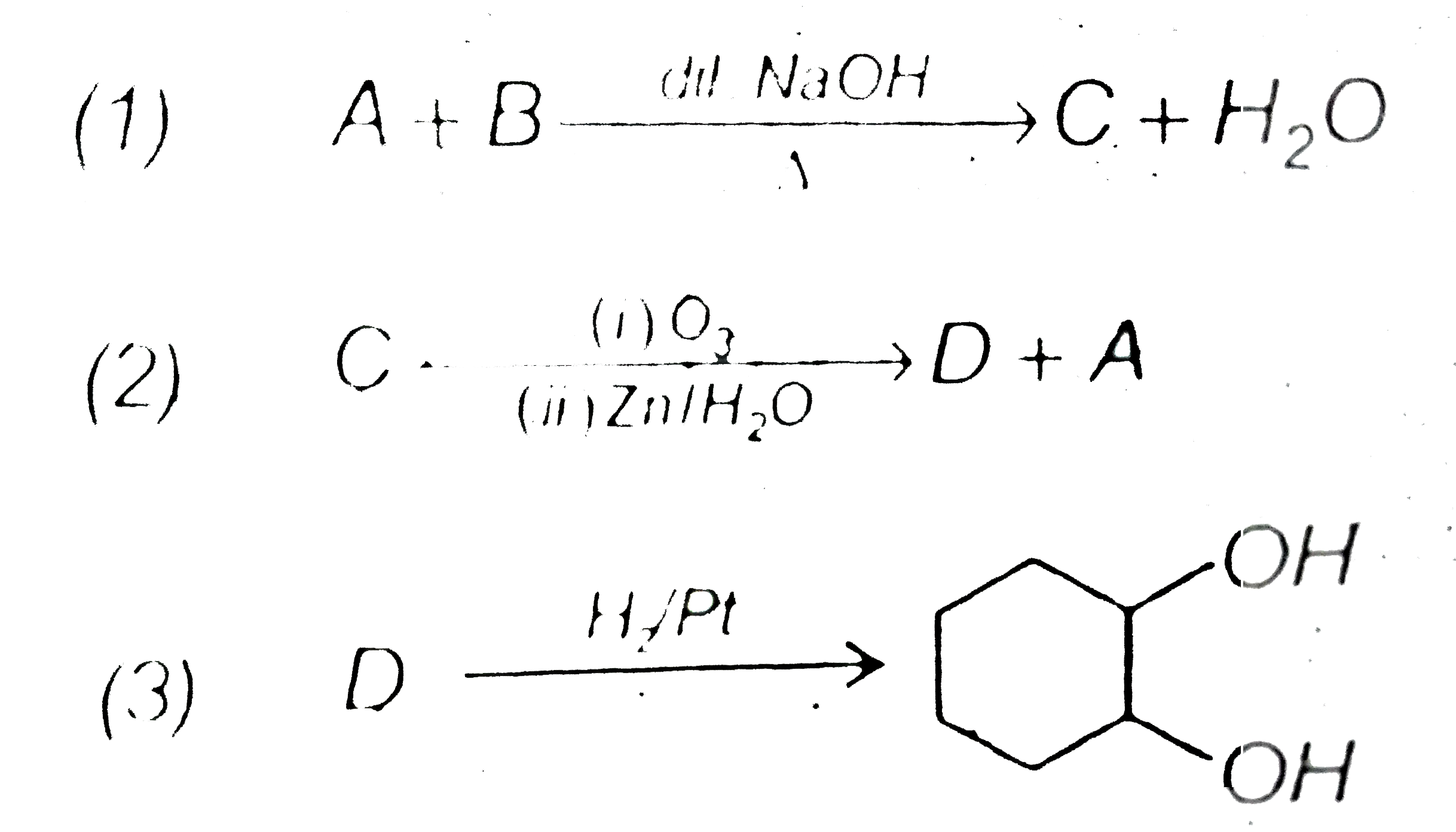Identify Z in the following reaction :
2H3CCOCH3i.Ba(OH)2−−−−−−−→ii.Δ,H+Z
H3CCH2CO2H
2H3CCO2H
H3CCOCH2CO2H
H3C−C∣CH3=CHCOCH3
The correct Answer is:D
To identify Z in the given reaction involving acetone (2H₃C COCH₃), we will go through the steps of the reaction systematically.
1. Identify the Reactants:
The reactants are two moles of acetone, which has the structure CH₃C(=O)CH₃.
2. First Step - Reaction with Ba(OH)₂:
In the first step, we treat the acetone with barium hydroxide (Ba(OH)₂). The hydroxide ion (OH⁻) from Ba(OH)₂ acts as a base and abstracts a proton (H⁺) from one of the methyl groups (CH₃) of acetone. This results in the formation of an enolate ion:
CH₃C(=O)CH₂⁻
3. Nucleophilic Attack:
The enolate ion formed in the previous step acts as a nucleophile and attacks the carbonyl carbon of another acetone molecule. This leads to the formation of a β-hydroxy ketone:
CH₃C(=O)CH₂C(OH)(CH₃)₂
4. Second Step - Protonation and Heating:
In the second step, we add an acid (H⁺) and heat the reaction mixture. The negative charge on the oxygen of the β-hydroxy ketone is protonated, resulting in a hydroxyl group. Upon heating, a water molecule is eliminated, leading to the formation of an α,β-unsaturated ketone:
CH₃C(=O)CH=CH₂
5. Final Product - Identify Z:
The final product, which is Z, is an α,β-unsaturated ketone. The structure can be represented as:
CH₃C(=O)CH=CH₂
This compound is known as 4-methylpent-3-en-2-one.
Conclusion:
Thus, Z in the reaction is an α,β-unsaturated ketone, specifically 4-methylpent-3-en-2-one.
The reactants are two moles of acetone, which has the structure CH₃C(=O)CH₃.
In the first step, we treat the acetone with barium hydroxide (Ba(OH)₂). The hydroxide ion (OH⁻) from Ba(OH)₂ acts as a base and abstracts a proton (H⁺) from one of the methyl groups (CH₃) of acetone. This results in the formation of an enolate ion:
CH₃C(=O)CH₂⁻
The enolate ion formed in the previous step acts as a nucleophile and attacks the carbonyl carbon of another acetone molecule. This leads to the formation of a β-hydroxy ketone:
CH₃C(=O)CH₂C(OH)(CH₃)₂
In the second step, we add an acid (H⁺) and heat the reaction mixture. The negative charge on the oxygen of the β-hydroxy ketone is protonated, resulting in a hydroxyl group. Upon heating, a water molecule is eliminated, leading to the formation of an α,β-unsaturated ketone:
CH₃C(=O)CH=CH₂
The final product, which is Z, is an α,β-unsaturated ketone. The structure can be represented as:
CH₃C(=O)CH=CH₂
This compound is known as 4-methylpent-3-en-2-one.
Thus, Z in the reaction is an α,β-unsaturated ketone, specifically 4-methylpent-3-en-2-one.
Topper's Solved these Questions
- BOOK - TARGET PUBLICATIONCHAPTER - ALDEHYDES, KETONES AND CARBOXYLIC ACIDSEXERCISE - EVALUATION TEST19videos
ALDEHYDES, KETONES AND CARBOXYLIC ACIDS
- BOOK - TARGET PUBLICATIONCHAPTER - ALDEHYDES, KETONES AND CARBOXYLIC ACIDSEXERCISE - CRITICAL THINKING52videos
ALDEHYDES, KETONES AND CARBOXYLIC ACIDS
- BOOK - TARGET PUBLICATIONCHAPTER - ALCOHOLS, PHENOLS AND ETHERS EXERCISE - EVALUATION TEST21videos
ALCOHOLS, PHENOLS AND ETHERS
- BOOK - TARGET PUBLICATIONCHAPTER - BIOMOLECULES EXERCISE - Evaluation Test10videos
BIOMOLECULES
Similar Questions
Identify X, Y and Z in the following reaction :
C6H5NH2NaNO2/HCl−−−−−−−−−−→0−5∘CXH2O/H+−−−−−−−−→WarmYZn−−−−−→HeatZ.View SolutionIdentify X, Y and Z in the following reactions :
(a) C6H5NH2NaNO2−−−−→HClXCuBr−−→HBrY−−−−−−−−→623 K, pressureZ
(b) C6H6Cl2.FeCl3−−−−−→XCuCN−−−→Ydil.HCl−−−−→Z
(c) C6H5N+2Cl−KI−−→warmXCu−−→YView Solution
Knowledge Check
- Question 1 - Select One
Identify Z in the following sequence of reactions -
CH3COONH4Δ−−→XP2O5−−→YH2∅H−−→ZACH3−CH2−CO−NH2BCH3−CNC(CH3CO)2DCH3−COOH - Question 2 - Select One
Identify A,B,C in the following reaction :
CH3COCH3H2/Ni−−−→ASOCl2−−−→BKOH/alc.−−−−−−→CACH3CHOHCH3,CH3CHClCH3,CH3CHOHCH3BCH3CHOHCH3,CH3CHClCH3,CH3CH=CH2CCH3CH2CH2OH,CH3CH2CH2Cl,CH3CH2CH2OHDCH3CH2CH2OH,CH3CH2CH2Cl,CH3CH=CH2 - Question 3 - Select One
Identify product P in the following reaction sequence.
CH3CH2OHGrignard reagent−−−−−−−−−→dry ether ΔA↓C2H5OHP+BAAn alcoholBAn etherCAn acidDAn ester
Identify A-D in the following reactions .

(1) A+BdilNaOH−−−−−→ΔC+H2O
(2) CdilNaOH−−−−−−−→(ii)Zn/H2OD+A
(3) View Solution
View SolutionPredict the major product in the following reaction :
C6H5−CH2COCH3(i)CH3MgBr(excess)−−−−−−−−−−−−−→(ii)H+View SolutionIdentify the major product in the following reactions :
C6H5−CH2−H∣C∣Br−CH3Alc.KOH−−−−−→Δ?HBr−−→ ?View SolutionCompounds (A) and (C ) in the following reactions are
CH3CHO(i)CH3MgBr−−−−−−−−→(ii)H2O(A)H2SO4,Δ−−−−−−→(B)Hydroboration oxidation−−−−−−−−−−−−−−→(C)View SolutionIdentify C in the following reaction
C2H2Chromic acid−−−−−−−→ANH3−−→BΔ−−−→−H2OCView Solution

